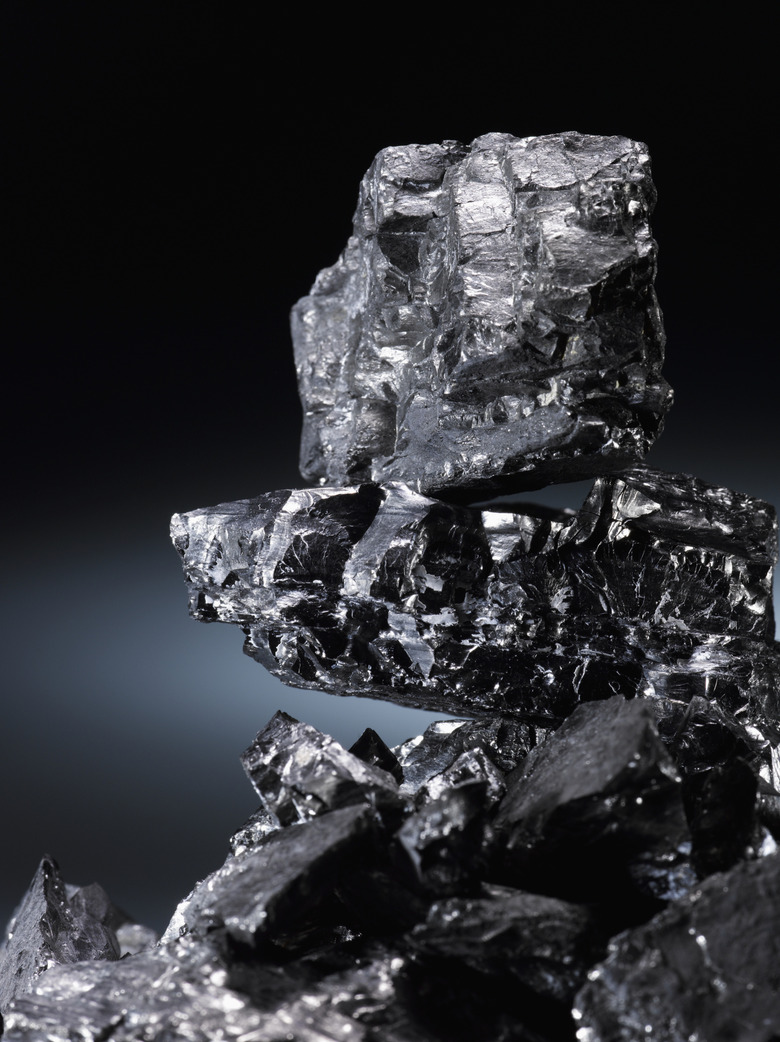What Do Fossil Fuels Look Like?
The three major fossil fuels — coal, oil and natural gas — were formed hundreds of millions of years ago from dead organic matter. Over this long period of time, layers of rock, soil and water covered the organic matter and eventually turned it into coal, oil or gas. While all fossil fuels formed in the same basic way, they each have their own distinct appearance.
Coal
Coal
Coal is a solid black, rock-like substance made up of carbon, hydrogen, nitrogen, oxygen and sulfur. The more carbon present in coal, the harder it is and the more energy content it contains. Coal formed from layers of dead trees and plants, called peat, which were deposited to the bottom of swamps and oceans. Peat was covered by sand and clay, which pressed out the water, and the peat turned into coal over millions of years. In addition to its solid form, coal can be converted to a liquid, which allows coal to be used as an alternative to oil. Benefits of using liquid coal instead of other fossil fuels include its relatively cheaper cost, its lack of sulfur and relatively low nitrous oxide emissions, and its use as a cooking fuel with less indoor air pollution.
Oil
Oil
Oil was formed from sea organisms called diatoms that died and fell to the sea floor. They were buried under sand and rock, and the carbon present in these organisms turned into oil through decomposition by bacteria and vast amounts of pressure and heat. As earth shifted, oil and natural gas became trapped in folds of rock. Crude oil is liquid that can be very thick or thin and has various shades from dark brown to black, or sometimes it is even a colorless liquid. Oil refineries distill the components of crude oil for processing into products like gasoline, motor oil and asphalt.
Natural Gas
Natural Gas
Natural gas on its own is odorless and invisible. It is lighter than air and made up mostly of methane gas, or CH4. You might use natural gas in your home, typically for your stove or heater, and you might have heard the gas company warn you about smelling natural gas. Before natural gas reaches your home, the gas company mixes it with mercaptan to give natural gas a distinctive, rotten-egg-like smell; this odor helps you notice a gas leak.
Oil Shale
Oil Shale
While coal, oil and natural gas are the most common and recognized fossil fuels, other fossil fuels like oil shale contain bituminous materials, or heavy black oil, that can be used as a source of energy. Oil shale is a sedimentary rock that, similar to other fossil fuels, formed from dead organic matter that fell to the bottoms of lakes and seas. Oil shale formed in these cases because the heat and pressure was not great enough to create coal or oil. Solid oil substances are extracted from oil shale by heating, separating and collecting the oil in a liquid form. Similarly, tar sands, which are combinations of black clay, sand and bitumen, are mined to extract the oil from the clay and sand.
Cite This Article
MLA
Batema, Cara. "What Do Fossil Fuels Look Like?" sciencing.com, https://www.sciencing.com/fossil-fuels-look-like-12688/. 24 April 2017.
APA
Batema, Cara. (2017, April 24). What Do Fossil Fuels Look Like?. sciencing.com. Retrieved from https://www.sciencing.com/fossil-fuels-look-like-12688/
Chicago
Batema, Cara. What Do Fossil Fuels Look Like? last modified March 24, 2022. https://www.sciencing.com/fossil-fuels-look-like-12688/
